Blog: 3 Ways That International Research Can Uncover Amazon Opportunities
3 Ways That International Research Can Uncover Amazon Opportunities
In business, there are two ways that you can grow: vertically or horizontally.
By this, I mean that you could sell more of your product and related products in the same marketplace. This would be growing vertically. Or you could focus on selling in new marketplaces and channels. This is horizontal growth.
We have been working hard for months to build the Web App to support international marketplaces, and last week this came to fruition! The Jungle Scout Web App and Chrome Extension now supports five international Amazon stores: US, UK, Canada, France, and Germany. Expanding your Amazon product sales to new international markets remains an untapped opportunity for sellers.
Expanding Amazon sales overseas is an untapped opportunity. #amazon #fba #growth Click To Tweet
We wrote about the functionality of how to use Jungle Scout for these markets in detail here. It is dead simple.
Today I want to share a few tips for how you can use this new functionality to your advantage.
Regardless of whether you are selling on Amazon or not, or how much you are currently selling, there are valuable tips here.
Alright, let me become an International Man Of Mystery wig and see what Amazon product opportunities we can dig up….

Strategy #1: Growth Opportunities For Your Existing Product
If you are already selling on Amazon, the easiest first step with a low barrier to entry is seeing how your product sells in other markets.
This is a great strategy for expansion because you do not need to worry about finding your product idea, supplier, importer, package design, product listing, etc. All you need to do is see if there is existing demand in other markets, and if there is, voila….you have a new market to sell in!
Note: there is paperwork you need to go through to establish an overseas legal entity for each country (necessary to open an Amazon store overseas). I will cover this in a future post.
So let’s take my bamboo marshmallow sticks, Jungle Stix. They have been doing quite well in the Amazon US store, from $10-$27k per month.
Is there a market to sell these in other Amazon marketplaces?
I have just the solution for that answer…..time to fire up Jungle Scout!
Just as a point of reference, here is Jungle Stix in the Product Database when I search for the keyword “marshmallow sticks” in the US market:
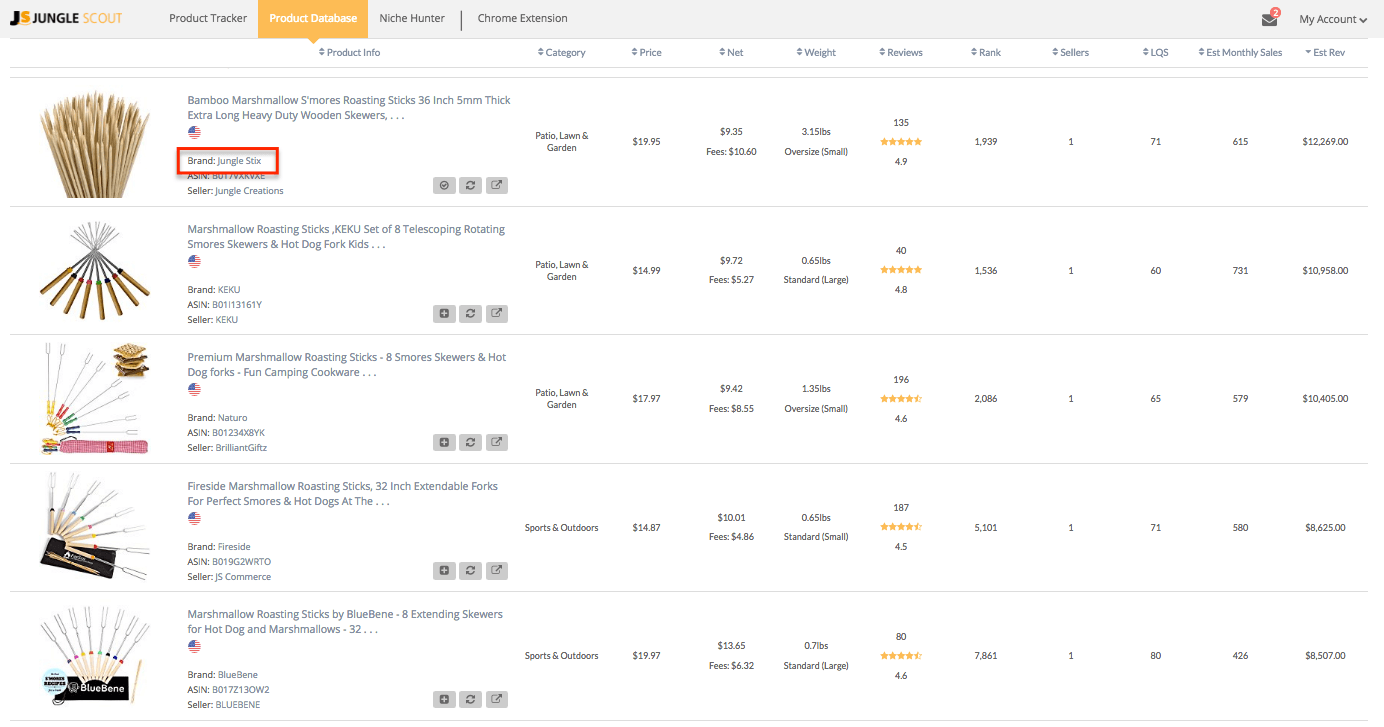
There are dozens of search results.
I’m curious to see though what the demand for marshmallow sticks is in other markets. Until I sharpen up my German and French, let’s just stick to the English-speaking markets of Canada and UK.
If we want to use the Product Database, just click the Canadian flag, and you can enter your keyword (like I did below), or just search based on the various filter criteria you can use:
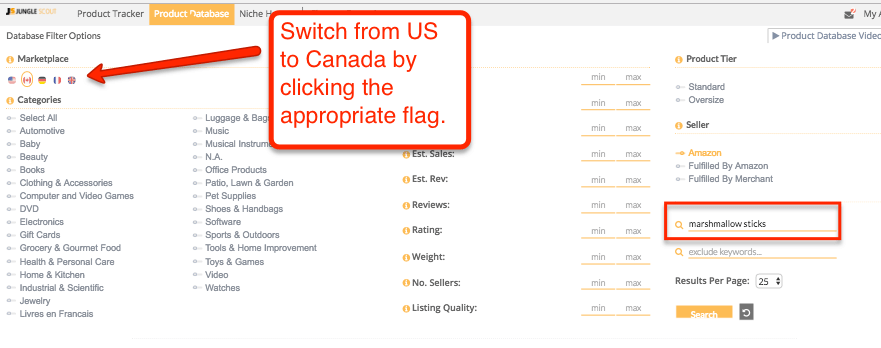
Here is a look at the organic search results for “bamboo marshmallow sticks” in the Canadian marketplace:
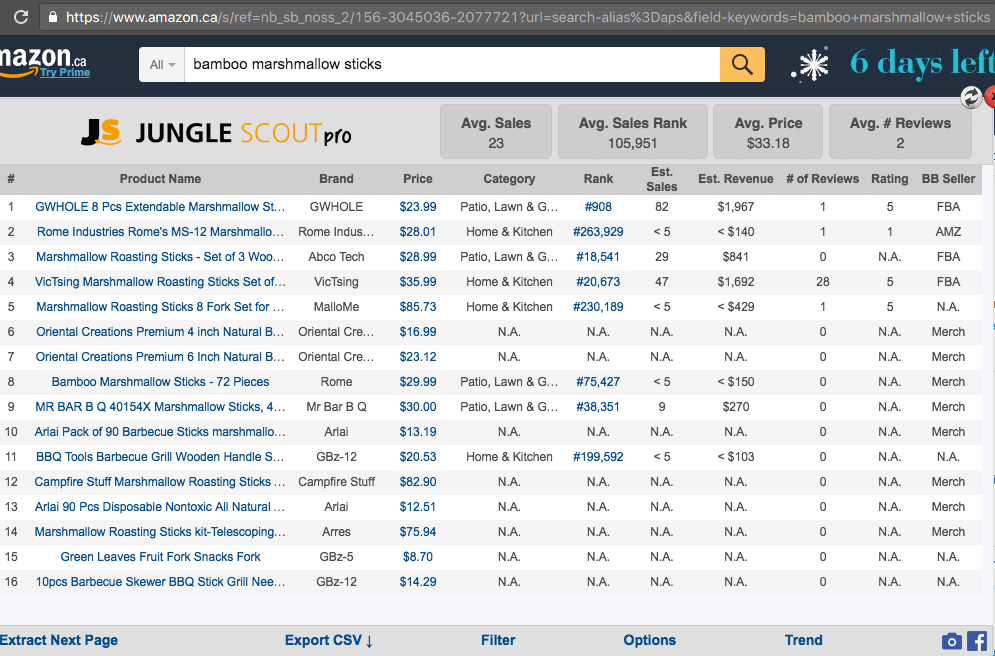
And the Jungle Scout results from the UK marketplace:
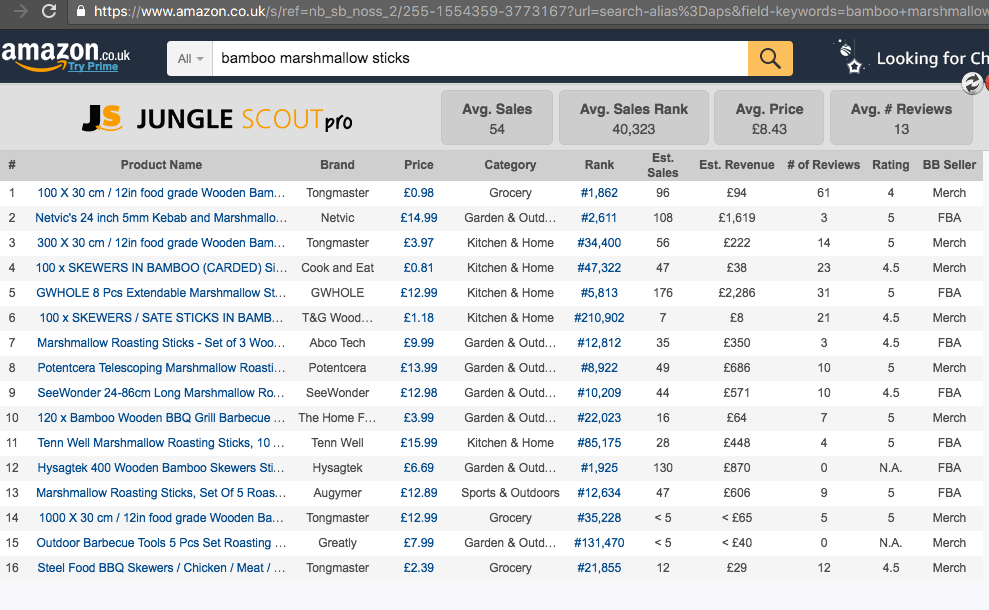
My first impression is that there is not a lot of existing demand in these markets. Perhaps s’mores are definitively American? I hope Canadians and English can experience the beauty of a warming, gooey, chocolatey s’more, there’s nothing better! Anyway…..
How do we know if what we are seeing in the lack of sales is based on a lack of supply or a lack of demand?
One easy way to figure this out is to look at the search volume, as provided by Google’s Keyword Planner. You can get the aggregated search volume for a given keyword, and see how it is distributed across different locations.
For example, this is how searches are broken down for the US, UK, and Canada for “bamboo marshmallow sticks”:
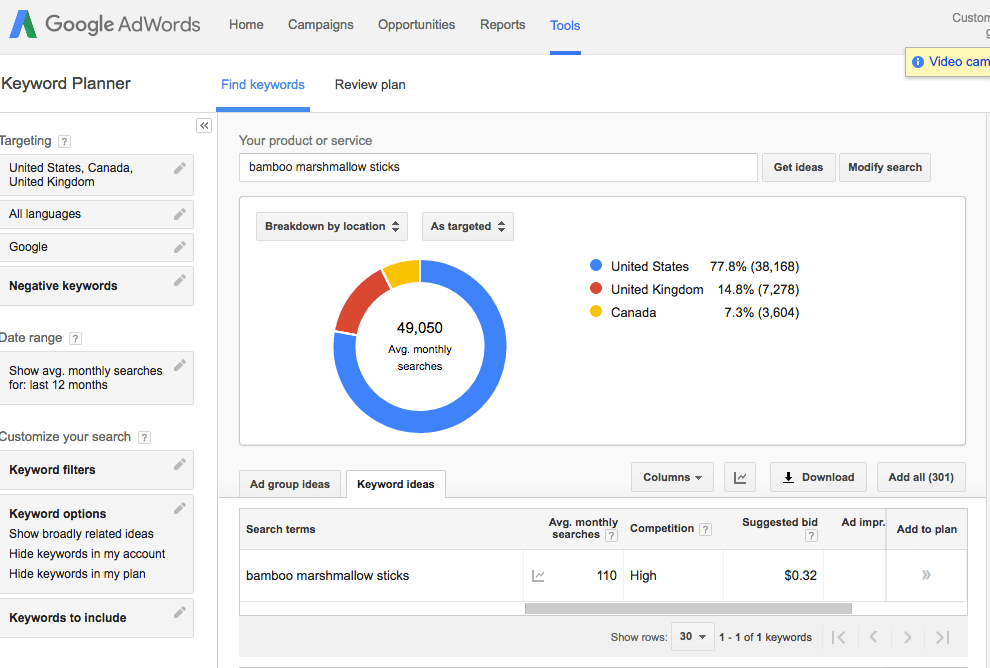
You can get search volume data based on location in Google Keyword Planner by adding your location in the “Targeting” section in the left column. I think that this is more helpful as a method to see the distribution of search volume–so you can see that there are about 5x searches for keywords related to “bamboo marshmallow sticks” in the US than the UK. And there are 2x more in the UK than Canada.
I don’t know if this is a home run opportunity in the UK or Canada like it was in the US, but that’s exactly why these research tips are so helpful. Our opportunity will come….as we continue searching.
Strategy #2: Launch US Niches Overseas
Another strategy that we can use is to find niches that have opportunity in the US, and see if there is also growth opportunities overseas. This is a somewhat related strategy to what we did above, except we are going to cast a much wider net and use a different tool set.
Time to fire up the Niche Hunter!
The great thing about the Web App supporting the international marketplaces is that it has proprietary ratings for metrics like Opportunity Score, Competition, and Listing Quality Score, specific to each marketplace.
Here are some of the ideas that the Niche Hunter spits out for Canada:

These are some enticing options, as you can see there is significant demand (look at the Average Units Sold column–more than 1000 units sold for each of these products), low competition (looking at the Competition column, our proprietary algorithm shows a low competitive score), and the Opportunity Score is very high–89 and 90!
Furthermore, these are some interesting niches that I didn’t know existed, so these may pass my “Weirdness Test” where I am looking for obscure products that are not easily found at your local brick and mortar store.
And clicking in on any of these, I can quickly get an overview of how the top sellers in the niche are doing, with sales, reviews, related keywords, and the top sellers for the keyword.
For example, “thermal Laminating Pouches” sound interesting, look like they have promise based on demand, competition, and Opportunity Score. So if I click on that option in the Niche Hunter, I get a comprehensive overview of the niche:
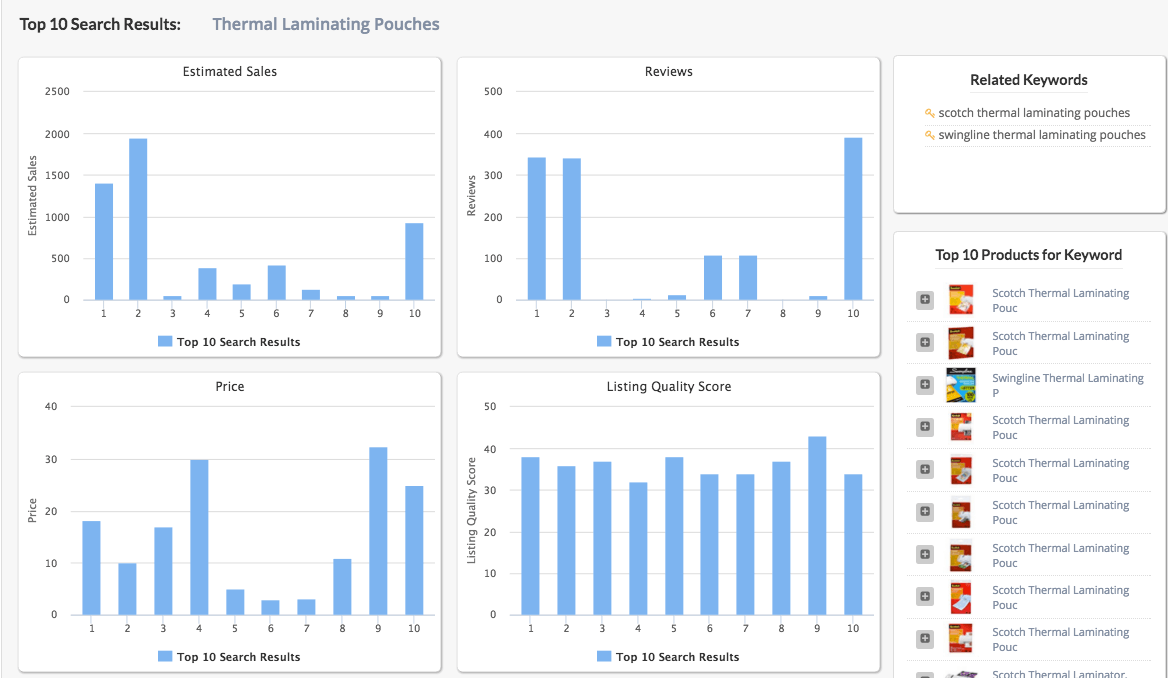
From here, I would probably want to pop in “thermal laminating pouches” into the Amazon store that I am interested in selling in, and verify with Jungle Scout's data estimates that there is in fact demand in other countries. Additionally, I can try the “Related Keywords” that the Niche Hunter shows, adding keywords like “scotch thermal laminating pouches” or “swingline thermal laminating pouches”.
The point here is that the Web App–particularly the Niche Hunter and Product Database–have results tailored to the unique countries. It is like having a cultural translator, sourcing agent, and analyst all rolled into one!
Strategy #3: The Reverse Engineer Private Label Success
I always like to see what is working for other people and how it can be modified and improved. For example, this approach can be used for sellers who sell a lot of product despite having a poor product (as evidenced by a poor rating) or a poor listing (with images, poor Product Title, etc).
This strategy can be applied to international sellers as well. Here’s how:
Start by searching in the Product Database for a specific country, but only look for private label sellers. You can ensure that it is a private label seller by including a Minimum and Maximum number of Sellers at 1. It will look like this:
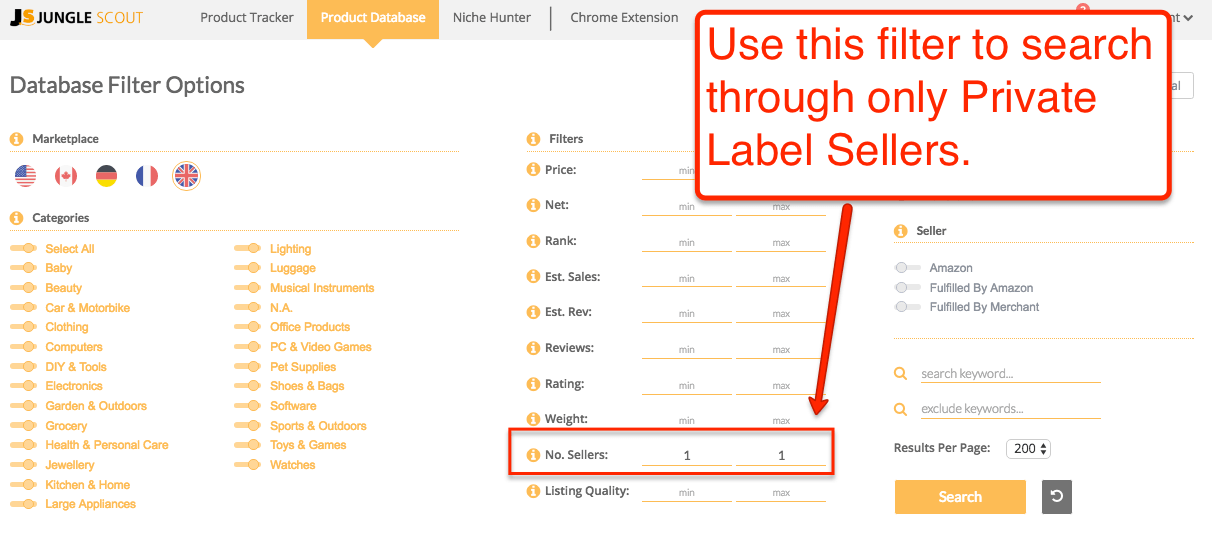
So all of the results will be private label sellers.
Do any of these products look interesting, like they would have sizeable demand if sold in the Amazon US store?
In just the top few results, here are some ideas that look intriguing



These may or may not make the cut of products that I would want to sell, but it is all about generating new ideas and thinking outside the box. Sourcing ideas from a new country is a fantastic place to start.
From here, I would drop these keywords into the Amazon US store, and check on how the sales are for these keywords.
For example, is there such a thing as a “car cane” in America?
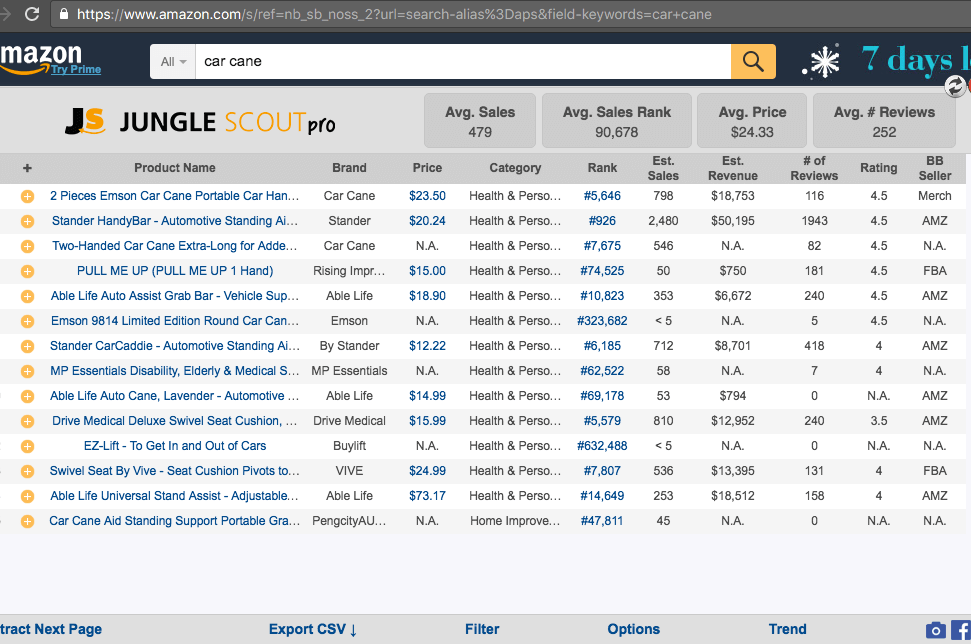
So it looks like it does exist, and actually some decent sales! There is some significant demand, and limited competition.
Here is a look at the Jungle Scout results for “car cane” on Amazon UK:
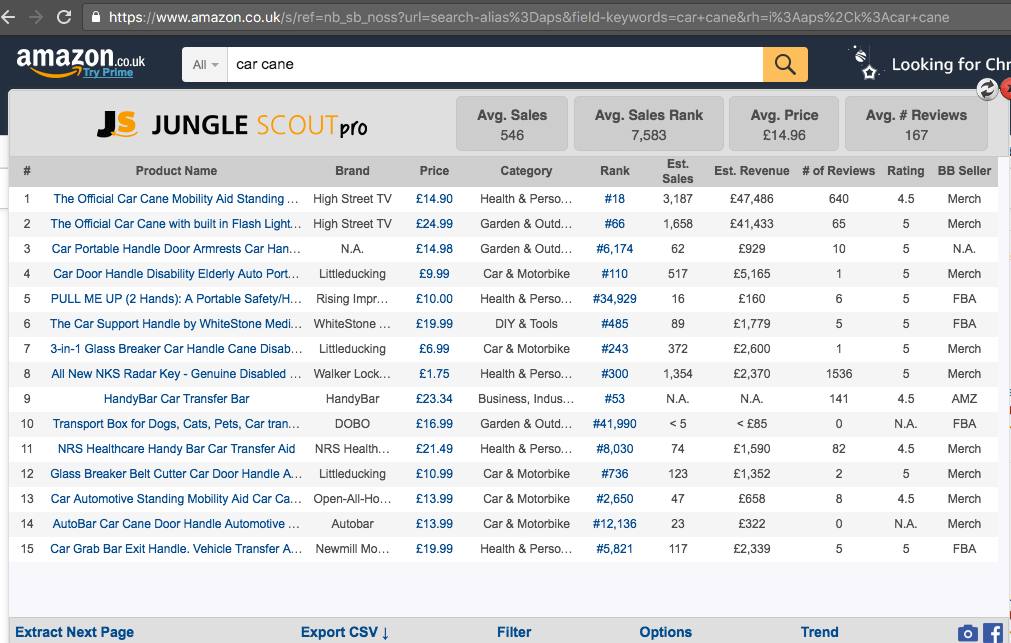
Another way that we could take advantage of cross-marketplace research is by finding new keywords and customer segments to target in our product listing. Essentially, study how top-performing counterparts in other countries market and sell a product similar to yours.
For example, this is how the top result for “car cane” in Amazon UK:
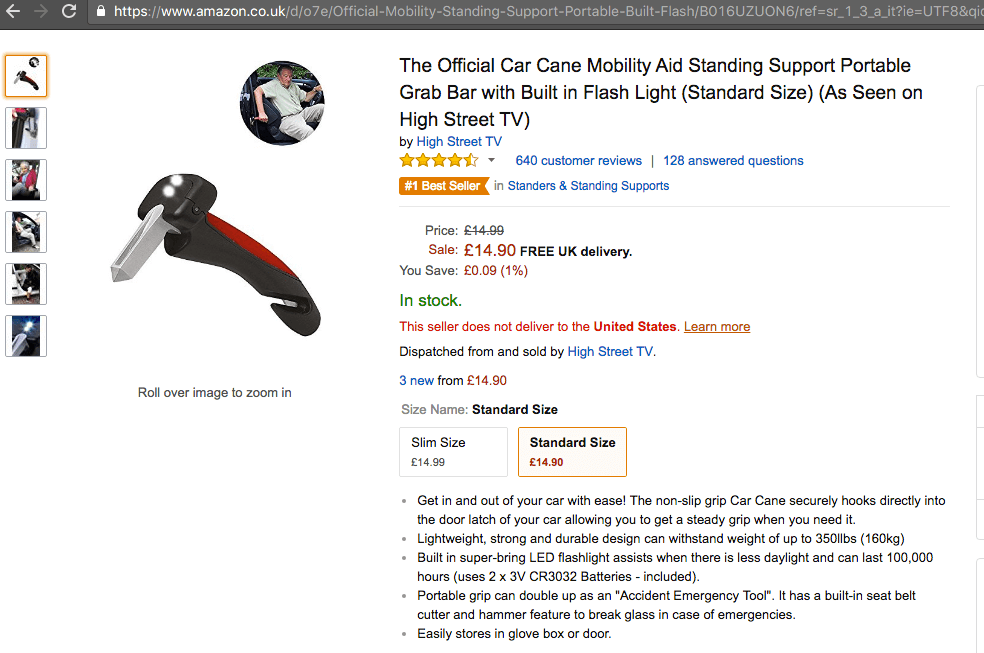
If I were selling a car cane in the US, I might want to look into various keywords (mobility aid, standing support, grab bar, etc), mybe some of the benefits offered (easy storage, portability), or even new product features (a car cane with a flashlight sounds amazingly helpful!).
These are all opportunities to improve a listing easily, and there is no doubt that it is working in the UK for this seller.
CONCLUSION
So there you have it, three simple ways to improve your sales, find new product ideas, and capitalize opportunities with Amazon (and Jungle Scout’s) international reach.
I will continue covering this topic of international expansion, because I believe that it is a huge opportunity to easily scale a business using existing infrastructure (as in your product, supplier, operations, etc).
How do you approach international sales as an Amazon seller? Share your questions or comments below and we can work together to earn….time to get back to work so we can start minting that money. Like lotssss of money….

